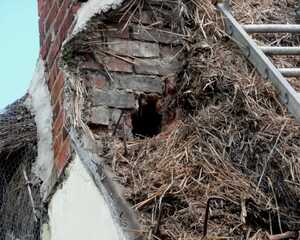
Height
To reduce the risks associated with ejected embers and sparks from the chimney, the recommended height from the thatch to the top of the chimney pot is 1.8 meters.
Condition
Chimneys should be checked to ensure the brick or stonework is in good condition. Old or poorly maintained unlined chimneys with loose or missing bricks and mortar, could allow hot gases and smoke to escape into upper rooms, the loft space or directly onto the thatch, especially if there is a build-up of soot or a bird’s nest, which could divert hot gases through imperfections in the chimney stack.
If re-thatching works are taking place and the thatch around the chimney stack is removed, the thatcher will be able to advise on its condition.
Liner
A number of thatch fires occur as a result of old or inappropriate flue liners, therefore chimneys serving either an open fire or multi-fuel appliance should be suitably lined. Contact an appropriate professional body such as HETAS so a registered chimney engineer can review the liner (if already installed) to ensure it is fit for purpose for the type of appliance or fire in use. An engineer will also be able to advise on the condition of the liner and recommend how often it should be checked.
If you are considering installing a wood burner or similar, contact HETAS who will advise on the most suitable appliance and liner for the properly.
Find out more on HETAS.
Spark Arrestor
A spark arrestor can become blocked with tar deposits, which in turn can slow down flue gases leaving the chimney and build up heat in the flue.
The general consensus is that if you don’t have a spark arrestor, don’t fit one, and if you do already have one, then it needs to be kept clean.
Before considering the possible removal of a spark arrestor, it is always advisable to gain confirmation from your insurance company.
Seasoned Wood
Always use dry seasoned wood. The sap in unseasoned wood is the main cause of tar deposits within a chimney or liner.
Moisture meters are readily available from many different sources and can be used to help you check that the moisture content of your seasoned wood is suitable to be used.
Maintenance
Ensure chimneys are regularly swept by an experienced and qualified chimney sweep. This normally needs to be done at least twice a year. However, if the chimney is used frequently during the winter period, then additional sweeping may be required. Your sweep will be able to offer you further advice.
Many chimney engineers and other specialist companies can offer a CCTV survey. This is recommended to check the internal condition of the flue. Again, check with your property insurer as some will have a list of approved companies.
New Works
If any part of the chimney including the appliance and liner is changed, then the recommendations contained in Approved Document J of the Building Regulations should be referred to. It is likely that you will need to seek the necessary planning and conservation approval for these works.